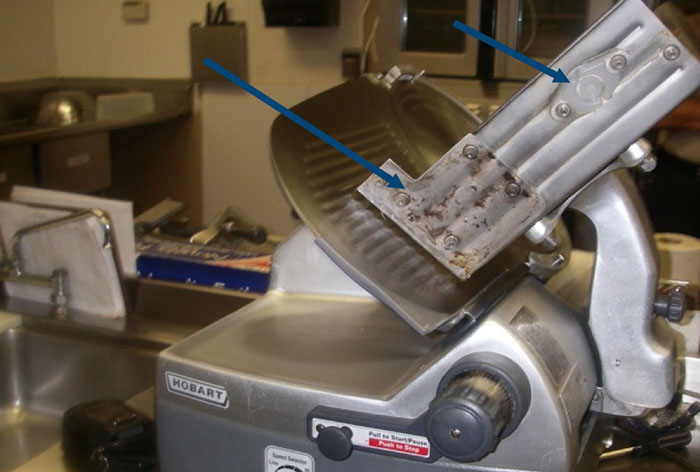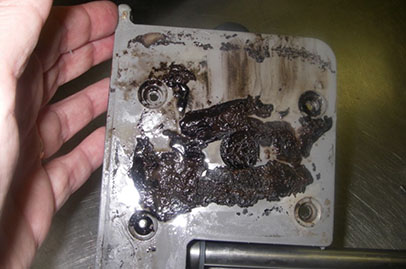 anet Anderberg and her colleagues at the Washington State Department of Health began investigating an outbreak of Salmonella connected to one franchise location of a national sandwich chain, she had never disassembled a commercial deli slicer. But when her lab returned samples from the kitchen that showed Salmonella contamination from the slicer, the food safety specialist knew she had to take a closer look.
anet Anderberg and her colleagues at the Washington State Department of Health began investigating an outbreak of Salmonella connected to one franchise location of a national sandwich chain, she had never disassembled a commercial deli slicer. But when her lab returned samples from the kitchen that showed Salmonella contamination from the slicer, the food safety specialist knew she had to take a closer look.What Anderberg found not only surprised her, but prompted a campaign that culminated a few years later in the changing of international standards for deli slicer design. Just under the handle of the slicer was a cache of black slime: decomposed bits of meat and other food that had squeezed through broken silicone seals and settled underneath, unreachable by the deep cleaning the slicer had received before she arrived, which included soaking the entire contraption in heavy-duty sanitizing solution.
This slime wasn’t just gross — it was a safety issue. At some point, food contaminated with Salmonella had fallen into this crevice under the handle and effectively colonized the decomposing food matter. Under the right circumstances, such as when cleaning water traveled through the crevices, the Salmonella would drip onto the food.
“A little bit of Salmonella oozed out every time they washed it,” Anderberg said. “It would emerge when they cleaned it and made the wet slicer assembly vertical — it just kind of drained out to where the meat was being sliced.”
That occasional dripping of Salmonella-contaminated water was enough to sicken at least 17 of the store’s customers over the course of several months. Most of the victims were among the first people to eat there in the morning after the slicer had been cleaned, including several employees.
And the problem wasn’t just with that one slicer. Anderberg soon inspected a slicer at another establishment from the same chain and found an identically grisly scene under the handle: black goo from years of food bits collecting through the broken silicone seals.
Other brands of slicers had the same problem, health officials quickly realized. The problem was soon found in slicer after slicer, some of which stay in use for up to 50 years. Any model of slicer designed with a plastic handle touching a metal base with a silicone seal seemed to be affected.
A hidden problem
In total, four foodborne illness outbreaks in the U.S. and Canada have been traced back to deli slicers harboring bacteria due to faulty design.
In 2008, the most deadly of those outbreaks resulted in the deaths of 22 people when cold cuts from Maple Leaf Foods in Toronto, Ontario, were contaminated with Listeria monocytogenes on the company’s production line. An investigation found that the design of the facility’s meat slicers rendered them impossible to completely clean.
Ultimately, 57 people were confirmed to have been sickened in the outbreak, and the company paid out $27 million in lawsuit settlements to victims’ families.
Listeria is most commonly associated with deli meats, to the point that women are discouraged from eating cold cuts while pregnant because of the risk of contracting Listeriosis, which can cause miscarriages and stillbirths.
A full 80 percent of Listeria illnesses linked to deli meat resulted from meat that was sliced at the retail or restaurant location where it was sold, according to Dr. Ernest Julian, chief of the Office of Food Protection at the Rhode Island Department of Health.
In 2010, a Salmonella outbreak in Rhode Island was ultimately traced back to a slicer in a deli. At some point, tomatoes contaminated with Salmonella were prepared in the machine, leaving food debris behind in impossible-to-clean areas.

“It’s a hidden hazard,” Julian said. “You look at it and it looks OK, but there’s this hairline crack with all this food debris getting through it.”
Solutions slow to make impact
In 2010, three years after the outbreak in Washington, two of the major accreditation bodies reviewing food slicers set new standards for approving slicers. Both NSF International and the American National Standards Institute agreed that, going forward, they would not certify slicers with impossible-to-clean areas in their designs.
“NSF’s revisions are designed to help reduce microbial cross-contamination in deli slicers that can occur as the equipment experiences wear and tear over time,” said Sarah Krol, global managing director of NSF International’s Food Safety Product Certification.
Slicer manufacturers looking to get these certifications now usually turn to one-piece, all-metal designs. Or, if the equipment has multiple pieces, they’re designed in a way that makes it easier to sanitize each part.
Anderberg from the Washington Department of Health had testified in front of officials from NSF and various slicer manufacturers prior to development of the new standards. The sandwich chain involved in the outbreak replaced the slicers in each of their locations around Washington state, while a number of other restaurants and grocery stores did the same.
But the slicers, which cost anywhere from $1,500 to $5,000, usually don’t go to a landfill when they’re replaced at a national chain.
“Your best places, the chains, they’ll replace them, but then they can end up in mom-and-pop places for decades,” Julian said.
He noted that there are still thousands of slicers in operation that are impossible to completely clean. It’s a problem that seems ripe for a novel solution.
In fact, Julian himself has suggested a solution to manufacturers — something similar to the federal “Cash for Clunkers” campaign designed to get older, less fuel-efficient vehicles off the road while stimulating the economy.
“What the manufacturers need to do is offer some kind of deal to give a certain percentage off a new slicer to replace an old one,” he said. “They’d sell new slicers while decreasing their liability. The companies say it’s a maintenance issue, but it’s really a design issue.”







